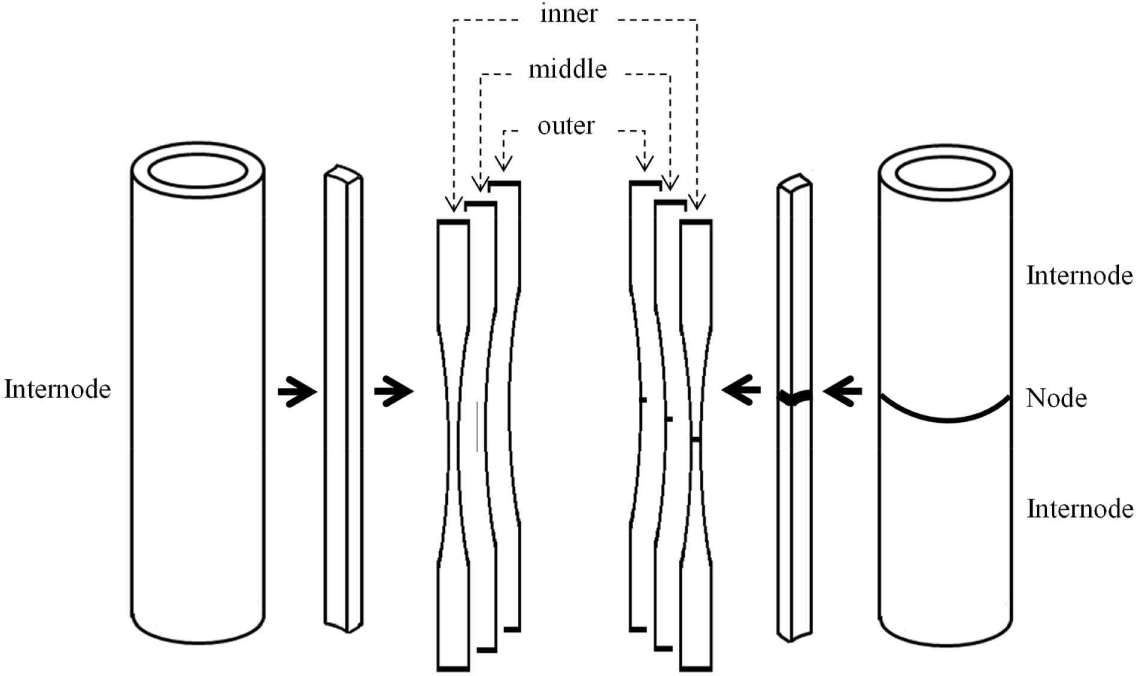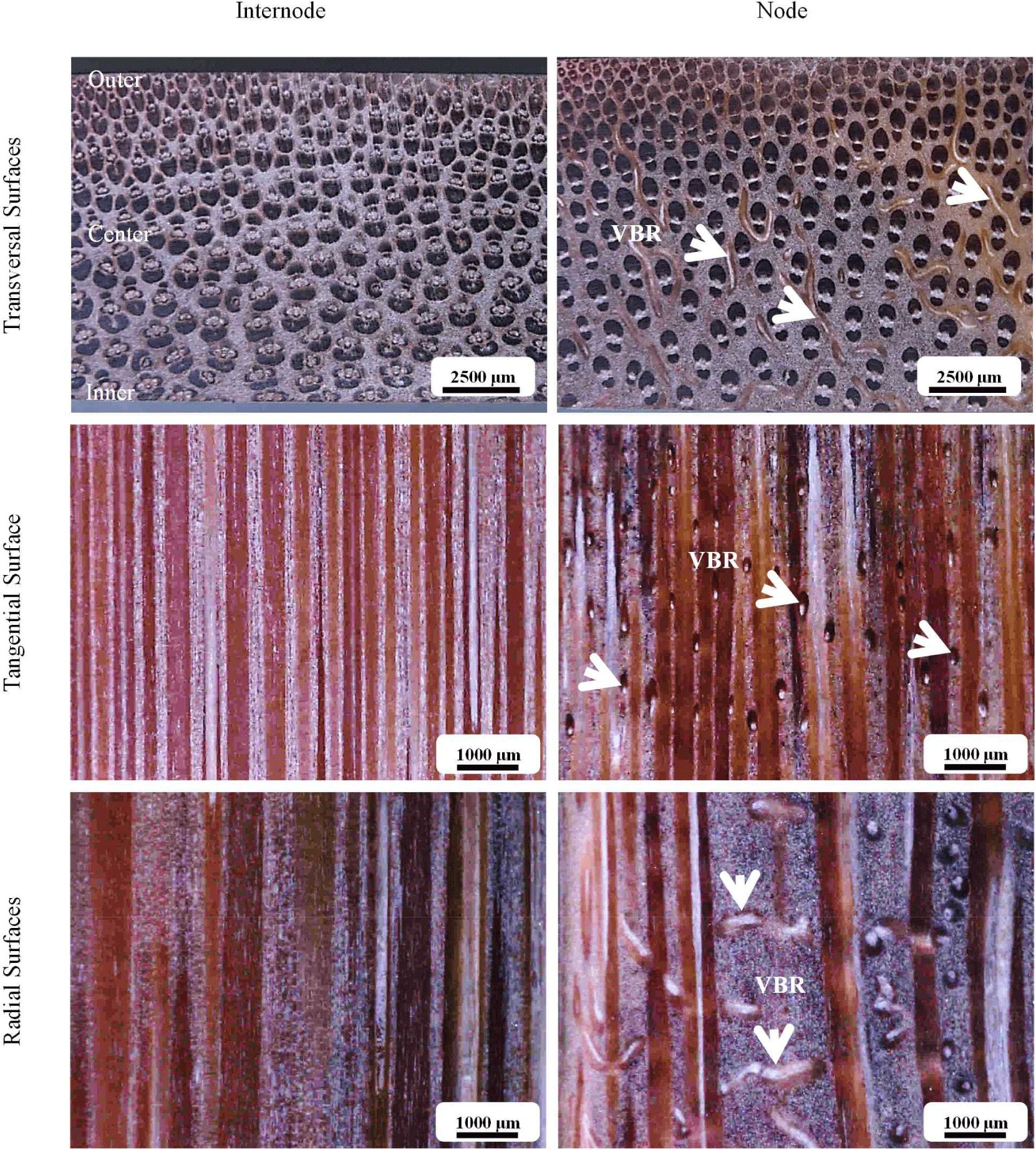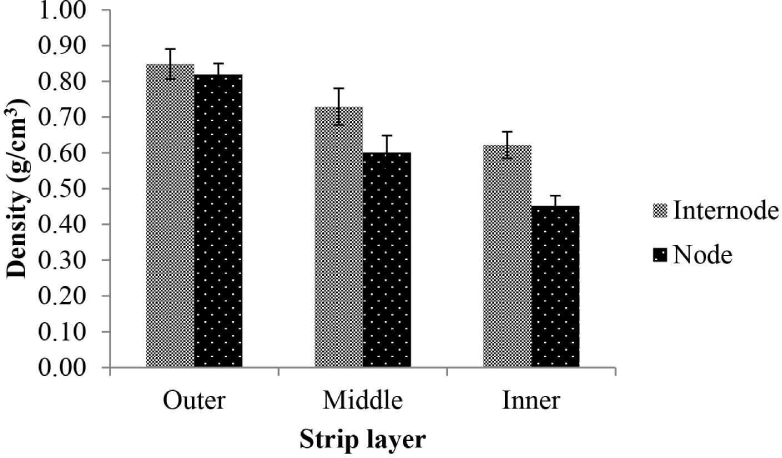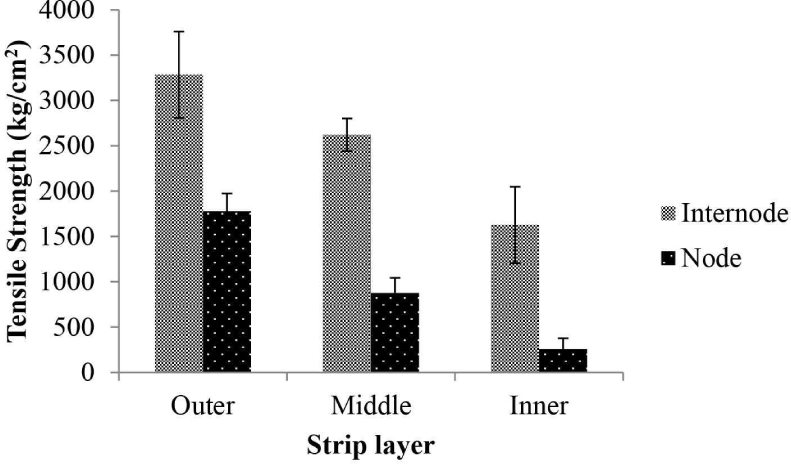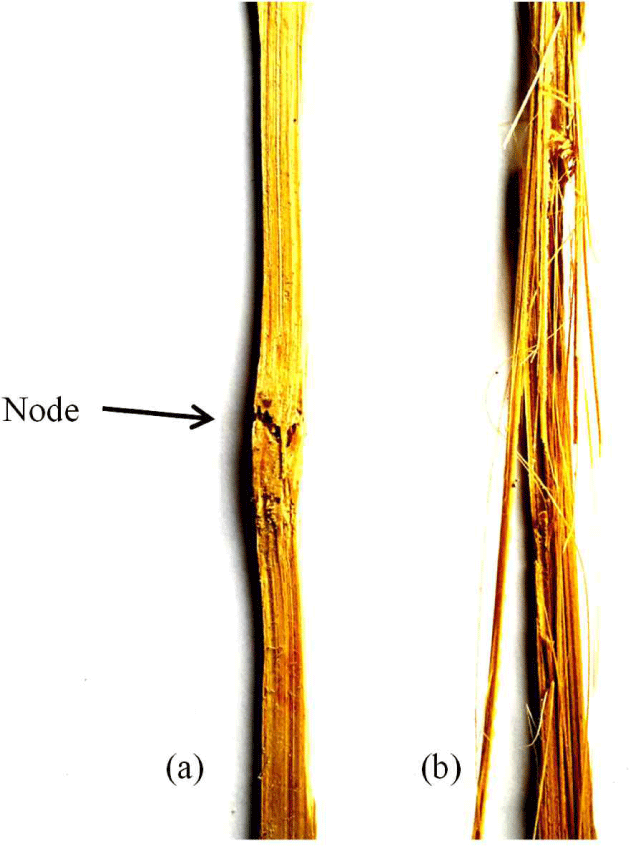Original Article
Effect of Vascular Bundles and Fiber Sheaths in Nodes and Internodes of Gigantochloa apus Bamboo Strips on Tensile Strength
Atmawi DARWIS1,
Anne HADIYANE1,
Endah SULISTYAWATI1,
Ihak SUMARDI1,†
Author Information & Copyright ▼
1School of Life Sciences and Technology, Institut Teknologi Bandung, Bandung 40132, Indonesia
Copyright 2023 The Korean Society of Wood Science & Technology. This is an Open-Access article distributed under the terms of the
Creative Commons Attribution Non-Commercial License (http://creativecommons.org/licenses/by-nc/4.0/) which permits
unrestricted non-commercial use, distribution, and reproduction in any
medium, provided the original work is properly cited.
Received: Feb 02, 2023; Revised: Apr 27, 2023; Accepted: Jun 29, 2023
Published Online: Jul 25, 2023
ABSTRACT
Bamboo culm is in the form of a tube/pipe, composed of internodes which are bounded by a partition/diaphragm (node). Anatomically, bamboo is composed of vascular bundles and parenchyma ground tissue. One of the constituents of vascular bundles is fibers that are grouped to form a fiber sheath. The anatomical structure of the nodes and internodes is thought to influence the strength of bamboo strips, including tensile strength. This study aimed to determine the characteristics of vascular bundles (distribution and fiber percentage) and their effects on the density and tensile strength of Gigantochloa apus bamboo strips with and without nodes. The bamboo culms were divided into three parts (outer, middle, and inner) along the radial direction. The results showed that the distribution of vascular bundles and percentage of fiber sheaths decreased significantly from the outer to the inner layer. This also had a significantly decreased density and tensile strength. Furthermore, the number of vascular bundles (in the transverse plane) was greater in the internodes than in the nodes. Anatomically, the orientation of the vascular bundles at irregular nodes is observed in the radial and tangential planes, where the direction is not only in the axial direction, but also in the radial and tangential directions. This caused the tensile strength of the G. apus bamboo strips to be lower at the nodes than at the internodes.
Keywords: Gigantochloa apus; node; internode; vascular bundle; fiber sheath; tensile strength
1. INTRODUCTION
Bamboo culms can be used as substitutes for wood for various purposes, such as crafts, furniture, and building materials. Using bamboo can reduce the use of wood to preserve sustainable forests. Bamboo supports the community’s economy and cannot be separated from people’s lives. Bamboo is a biological product with various properties owing to variations in the bamboo culm, age, and type of bamboo (Gao et al., 2022; Wahab et al., 2010).
Morphologically, bamboo culms comprise pipe- or tube-like structures (internodes) arranged lengthwise and bounded by partitions or diaphragms (nodes). The distance between the partitions on the bamboo culm varies from base to top; it increases from the base to the middle, and then decreases toward the tips (Darwis and Iswanto, 2018; Darwis et al., 2018). The partitions on the bamboo (nodes) are where branches usually appear. In addition, the diameter of bamboo culms tends to decrease from the base to the top (Jeon et al., 2018b; Maulana et al., 2021a).
The use of column-shaped bamboo is limited; therefore, many culms are modified into other shapes. Various studies on bamboo and its properties include the development of bamboo strand boards (Maulana et al., 2021b), bamboo composites (Hwang and Oh, 2023), bamboo coloring (Lee and Lee, 2021), the termiticidal activity of bamboo vinegar against attacks by subterranean termites (Arsyad et al., 2020), and improvement of the properties of the fibers that make up the composite (Jain et al., 2022; Oh, 2020; Setyayunita et al., 2022). Increased durability of wood has also been carried out through bulk furfurylation (Li et al., 2020) and applied to wood materials (Hadi et al., 2022) and bamboo impregnation (Anwar et al., 2009) as applied to wood materials (Sumardi et al., 2020). Based on this study, the fibers that makeup bamboo need to be studied further, and research on vascular bundles is the focus of this study.
Bamboo comprises vascular bundles, with parenchymal cells as the basic tissue. Each vascular bundle of the bamboo culm consists of one or more small protoxylem vessels and two large metaxylem vessels. That is, both “protoxylem” and “metaxylem” consists of vessel elements (Liese, 1987). Vascular bundles in bamboo culms are distributed unevenly and tend to decrease in number from the outside to the inside (Darwis et al., 2020; Grosser and Liese, 1971; Jeon et al., 2018a). The cell arrangement characteristics in bamboo culms, such as the distribution of vascular bundles and the percentage of fiber sheaths, directly affect their physical and mechanical properties (Abdullah et al., 2017; Bahtiar et al., 2016; Li and Shen, 2011; Li et al., 2021a). According to Bahtiar et al. (2014), bamboo slats are a layered system in which the strength and stiffness of each layer are functions of the density of the vascular bundles. In this regard, the transformed cross-sectional method can be used as an analytical tool for estimating the strength and stiffness of bamboo slats and laminated bamboo. Furthermore, Bahtiar et al. (2014) showed that the ratio of the distribution of vascular bundles can be used in the transformed cross-section method as a substitute for the modulus of elasticity ratio because the theoretical results from the derived model do not differ from the empirical values.
Gigantochloa apus is a bamboo species widely found in various regions of Indonesia, especially in Java (Widjaja, 2001). The many benefits that can be obtained from bamboo make it familiar to the community. G. apus is still used in the form of culms, bamboo splits, or bamboo strips. This type of bamboo is used as a building material (pillars, walls, roofs, and floors), baskets, and handicrafts (Dransfield and Widjaja, 1995). Bamboo strips in the form of woven bamboo are generally used as raw materials in the handicraft industry. Bamboo splits and strips can be used as laminae in bamboo-laminated products (Galih et al., 2020; Kumar and Mandal, 2022; Sumardi et al., 2022; Verma and Chariar, 2012; Wang and Shao, 2020). Bamboo strips are obtained by splitting the bamboo into several parts depending on the desired width. Bamboo has good mechanical properties and can be used as a reinforcing material, such as particle boards (Iswanto et al., 2022), composite boards (Cha et al., 2022), ceramics (Hwang and Oh, 2023), and soil reinforcement materials (Rochim et al., 2020).
Basic studies on the mechanical properties of bamboo have been conducted using columns, splits, and strips. The tensile strength of bamboo has also become the focus of many researchers because of the characteristics of the cells, which tend to be parallel to the culm axis, especially in the internodes, and the changes in the cell direction that occur in the nodes. Previous studies reported variations in the tensile strength of bamboo splits, both radially and longitudinally (Abdullah et al., 2017). The tensile strength of Gigantochloa scortechinii bamboo strips decreases radially from the outer to the inner part (Razak et al., 2012). Based on the height of the bamboo culms, the tensile strength of Gigantochloa atter and G. apus bamboo splits was highest in the middle of the culm (Rochim et al., 2020). However, the tensile strength of G. apus bamboo strips in the radial direction has not yet been investigated. This study focused on the effects of vascular bundles and fiber sheath percentages in the nodes and internodes of G. apus bamboo strips on the density and tensile strength.
2. MATERIALS and METHODS
2.1. Materials
A 3-year-old Tali bamboo (G. apus) from Cikeruh Village, Jatinangor District, Sumedang Regency, West Java Province, Indonesia, was used in this study. The bamboo was obtained from a bamboo clump in the middle by cutting the base (first segment/internode).
2.2. Methods
2.2.1. Density and tensile strength testing
The bamboo culms with and without nodes were stripped into three parts (outer, middle, and inner), as shown in Fig. 1. The epidermis/outer and inner skin were removed from the culm. Because the wall thickness of the bamboo culms varied depending on their position in the axial direction (base to top), the size of the test samples for the density and tensile strength was modified from the BS 373:1957 standard (methods for testing small clear timber specimens). The outer, middle, and inner parts of the test samples were 300 mm (length) × 20 mm (width) × 6 mm (thickness). The tensile strength was measured using a Universal Tensile Testers-CY-6040A4 instrument (Chun Yen Testing Machines Co., LTD, Taichung city, Taiwan). The density and tensile strength tests were performed nine times.
Fig. 1.
Tensile strength test sample of Gigantochloa apus. Sampling is based on the radial direction of the bamboo strips.
Download Original Figure
2.2.2. Microscopic observation
Microscopic observations of the transverse, tangential and radial sections were conducted using a Nikon Eclipse E 200 stereomicroscope (Nikon, Tokyo, Japan). The sample was first divided into the three sections with a sharp knife. The distribution of the vascular bundles was determined by counting the number of vascular bundles in an area of 1 mm2. The percentage of fiber sheaths was calculated as the ratio of the area of the fiber sheaths in each observation area (mm2). Anatomical image data (distribution of vascular bundles and percentage of fiber sheaths) were analyzed using NIS-Elements v.4.00.00 imaging software.
2.2.3. Data analysis
A completely randomized factorial design was used to determine the effects of bamboo culms (nodes and internodes) and depth on bamboo culms (outer, middle, and inner layers). Statistical analyses were performed using IBM SPSS Statistics 19 software (IBM, Armonk, NY, USA) at p < 0.05. The influence of the distribution of vascular bundles and fiber sheaths on tensile strength was also analyzed by constructing a regression equation.
3. RESULTS and DISCUSSION
3.1. Distribution of vascular bundles and percentage of fiber sheaths Gigantochloa apus bamboo strips
The ground tissue system arises from the ground tissue meristem and consists of three simple tissues: parenchyma, collenchyma, and sclerenchyma. Bamboo culms are composed mainly of vascular bundles and parenchymal (parenchymatous) ground tissue derived from the ground tissue meristem. Similar to other monocot plants, these vascular bundles are distributed unevenly. The number and density of the vascular bundles decreased from the outer to the inner parts (Table 1). This phenomenon is also supported by the microscopic images of the bamboo cross sections shown in Figs. 2 and 3(a). According to Darwis et al. (2018), the varying size and shape of the vascular bundles cause variations in their distribution from the outer to the inner parts of the bamboo strips. The number of vascular bundles per unit area on the bamboo segments tended to be greater than that on the nodes in the radial direction (from the outer to the inner part). As shown in Table 1 and Fig. 2, the distribution of vascular bundles at the internodes was denser than that at the nodes of the bamboo strips.
Table 1.
The average value of the distribution of vascular bundles, percentage of fiber sheath, density, and tensile strength of Gigantochloa apus bamboo strips with nodes and without nodes (internode) and based on layers (outer, middle, and inner)
| Section |
Radial segment |
Distribution of vascular bundles (∑ number of VB/mm2) |
Percentage of fiber sheaths (%) |
Density (g/cm3) |
Tensile strength (kg/cm2) |
| Internode |
Outer |
8.33 ± 1.00a |
51.83 ± 5.41a |
0.85 ± 0.04a |
3,284.14 ± 476.30a |
| Middle |
4.89 ± 0.93b |
44.71 ± 5.47b |
0.73 ± 0.05b |
2,622.45 ± 179.34b |
| Inner |
4.22 ± 0.97b |
37.51 ± 6.24c |
0.62 ± 0.04c |
1,626.85 ± 421.03c |
| Average |
5.81 ± 2.06A |
44.68 ± 8.11A |
0.73 ± 0.10A |
2,511.15 ± 784.89A |
| Node |
Outer |
8.11 ± 0.78a |
44.11 ± 4.16b |
0.82 ± 0.03a |
1,777.68 ± 196.86c |
| Middle |
3.44 ± 0.53c |
31.93 ± 3.42d |
0.60 ± 0.05c |
875.83 ± 116.59d |
| Inner |
2.56 ± 0.53d |
23.12 ± 1.84e |
0.45 ± 0.03d |
258.28 ± 118.24e |
| Average |
4.70 ± 2.55B |
33.05 ± 9.32B |
0.62 ± 0.16B |
970.60 ± 654.97B |
Download Excel Table
Fig. 2.
Transverse, tangential, and radial sections of the internodes and nodes of Gigantochloa apus at 10× magnification. VBR: vascular bundle radially.
Download Original Figure
One of the components of vascular bundles is fibers, which is important in supporting the strength of bamboo culms (Amada et al., 1997). The fibers were arranged in groups to form a fiber sheath. The proportion of fibers was also unevenly arranged when viewed from the cross-section of the bamboo (Kenneth and Uzodinma, 2021; Li et al., 2021b). A decrease in the percentage of fiber sheath was clearly visible from the outer layer to the inner layer of the culm [Table 1 and Fig. 3(b)]. The dense distribution of vascular bundles in the outer part causes the proportion of fiber sheets to be greater than that in the middle or inner parts of the bamboo strips.
Fig. 3.
Distribution of vascular bundles (a) and percentage of fiber sheaths (b) of Gigantochloa apus bamboo strips at nodes and internodes in the outer, middle, and inner layers.
Download Original Figure
3.2. Density of the Gigantochloa apus bamboo strips
The density of G. apus bamboo strips in the internode and node sections varied from the outer to the inner layer (Fig. 4). The density of the bamboo strips decreased from the outer to the inner layer. The density of bamboo in the internode section tended to be greater than that in the node section. The density is directly proportional to the distribution of vascular bundles and the percentage of fiber sheath area in the bamboo, as shown in Table 1 and Fig. 5. The greater the percentage of vascular bundles and fiber sheath area, the higher the density of G. apus bamboo strips. Based on the results of Anwar et al. (2005), the density of G. scortechinii bamboo is also influenced by the two components of its anatomical structure. Furthermore, according to Abdullah et al. (2017), the macrostructure of the culm and the fiber content of vascular bundles affect the density of bamboo.
Fig. 4.
Density of Gigantochloa apus bamboo strips (outer, middle, and inner layers) at internode and node.
Download Original Figure
Fig. 5.
The relationship between the distribution of vascular bundles (a) and the percentage of fiber sheaths (b) and the density of Gigantochloa apus bamboo strips.
Download Original Figure
3.3. Tensile strength of Gigantochloa apus bamboo strips
The tensile strength of G. apus bamboo strips varied in the radial direction. The tensile strength of the bamboo strips decreased from the outer to the inner layer (Fig. 6). The distribution of vascular bundles and the percentage of the fiber sheath area in the bamboo strips were positively correlated with their tensile strength, as shown in Fig. 7. The greater the number of vascular bundles and percentage of fiber sheath area, the higher the tensile strength of G. apus bamboo strips. This was also proven by Liu et al. (2014) in the tensile strength testing of Moso bamboo (Phyllostachys pubescens Mazei ex H. de Lebaie) and Wang et al. (2014) on Dendrocalamus latiflorus Munro bamboo, where the proportion of fibers in the vascular bundles had a large effect on tensile strength. Fiber cells play an important role in determining the mechanical properties of wood. The proportion of fibers in an individual vascular bundle plays an important role in its tensile strength (Osorio et al., 2018). According to Li and Shen (2011) and Shang et al. (2021), the tensile strength of individual vascular bundles is the highest in the outer layers of the bamboo culm and tends to decrease toward the inner part. This was due to the higher proportion of the fiber sheath area in the outer vascular bundles compared to that in the inner part.
Fig. 6.
Tensile strength of Gigantochloa apus bamboo strips (outer, middle, and inner layers) at internodes and nodes.
Download Original Figure
Fig. 7.
The relationship between the distribution of vascular bundles (a) and the percentage of fiber sheaths (b) and the tensile strength of Gigantochloa apus strips.
Download Original Figure
As shown in Fig. 2, the distribution of vascular bundles at the nodes was lower than that at the internodes. In addition, the orientation of cells in the bamboo internodes is parallel to the axis of the culm (axial), whereas, in the bamboo nodes, the vascular bundles are arranged in an axial or radial direction (Huang et al., 2015; Wang and Shao, 2020). Both these differences impact the tensile strength, where the tensile strength of bamboo in the internode section tends to be greater than that of the node section (Liu et al., 2021). This was evidenced by the damage that occurred during the tensile test where the bamboo strips contained nodes, and the damage that occurred in the nodes (Fig. 8).
Fig. 8.
Differences in damage to bamboo strips with nodes (a) and without nodes (b) during a tensile test. In bamboo strips with nodes, the nodes are damaged, whereas, in bamboo strips without nodes (internodes), all parts are damaged.
Download Original Figure
Table 1 shows the correlation between the tensile strength of bamboo strips and the percentage of fiber sheath as a ratio, with values of 63.36 (outer layer), 58.65 (middle part), and 43.37 (inner layer) for the internode and 40.30 (outer layer), 27.43 (middle part), and 11.17 (inner layer). The ratio of the tensile strength to the percentage of the fiber sheath decreased from the outer layer to the inner layer. This shows that the percentage of fiber sheaths affects the tensile strength of the bamboo strips.
4. CONCLUSIONS
The distribution of vascular bundles and fiber sheath percentages in the internodes and nodes of G. apus bamboo varied in the radial direction. This affected the density and tensile strength of G. apus bamboo strips. The distribution of vascular bundles and percentage of fiber sheaths were positively correlated with the density and tensile strength of the bamboo strips. The orientation of the vascular bundles influenced the tensile strength of G. apus bamboo strips at the internodes and nodes. The radial orientation of the vascular bundles at the nodes of the bamboo strips caused the tensile strength to be lower than that of the internodes of the bamboo strips.
ACKNOWLEDGMENT
I would like to thank the Institut Teknologi Bandung for financial support of the research via the Research, Community Service and Innovation Program (P3MI-ITB 2018).
REFERENCES
Abdullah, A.H.D., Karlina, N., Rahmatiya, W., Mudaim, S., Patimah, Fajrin, A.R. 2017. Physical and mechanical properties of five Indonesian bamboos. IOP Conference Series: Earth and Environmental Science 60: 012014.


Amada, S., Ichikawa, Y., Munekata, T., Nagase, Y., Shimizu, H. 1997. Fiber texture and mechanical graded structure of bamboo. Composites Part B: Engineering 28(1–2): 13-20.


Anwar, U.M.K., Paridah, M.T., Hamdan, H., Sapuan, S.M., Bakar, E.S. 2009. Effect of curing time on physical and mechanical properties of phenolic-treated bamboo strips. Industrial Crops and Products 29(1): 214-219.


Anwar, U.M.K., Zaidon, A., Hamdan, H., Tamizi, M.M. 2005. Physical and mechanical properties of
Gigantochloa scortechinii bamboo splits and strips. Journal of Tropical Forest Science 17(1): 1-12.

Arsyad, W.O.M., Efiyanti, L., Trisatya, D.R. 2020. Termiticidal activity and chemical components of bamboo vinegar against subterranean termites under different pyrolysis temperatures. Journal of the Korean Wood Science and Technology 48(5): 641-650.


Bahtiar, E.T., Nugroho, N., Surjokusumo, S., Karlinasari, L., Darwis, A. 2014. Rasio ikatan pembuluh sebagai substitusi rasio modulus elastisitas pada analisa layer system pada bilah bambu dan bambu laminasi. Jurnal Teknik Sipil 21(2): 147-162.


Bahtiar, E.T., Nugroho, N., Surjokusumo, S., Karlinasari, L., Nawawi, D.S., Lestari, D.P. 2016. Pengaruh komponen kimia dan ikatan pembuluh terhadap kekuatan tarik bambu. Jurnal Teknik Sipil 23(1): 31-40.

Cha, M.S., Yoon, S.J., Kwon, J.H., Byeon, H.S., Park, H.M. 2022. Mechanical properties of cork composite boards reinforced with metal, glass fiber, and carbon fiber. Journal of the Korean Wood Science and Technology 50(6): 427-435.


Darwis, A., Iswanto, A.H. 2018. Morphological characteristics of
Bambusa vulgaris and the distribution and shape of vascular bundles therein. Journal of the Korean Wood Science and Technology 46(4): 315-322.


Darwis, A., Iswanto, A.H., Jeon, W.S., Kim, N.H., Wirjosentono, B., Susilowati, A., Hartono, R. 2020. Variation of quantitative anatomical characteristics in the culm of Belangke bamboo (
Gigantochloa pruriens). BioResources 15(3): 6617-6626.


Darwis, A., Sumardi, I., Suhaya, Y., Sunarya, S. 2018. Characteristic of vascular bundles and morphology of
Gigantochloa apus (J.A. and J.H. Schulltes) Kurz culm. Asian Journal of Plant Sciences 17(3): 129-133.


Dransfield, S., Widjaja, E.A. 1995. Plant Resources of South-East Asia. No. 7: Bamboos. Backhuys, Leiden, The Netherlands. p. 189.

Galih, N.M., Yang, S.M., Yu, S.M., Kang, S.G. 2020. Study on the mechanical properties of tropical hybrid cross laminated timber using bamboo laminated board as core layer. Journal of the Korean Wood Science and Technology 48(2): 245-252.


Gao, X., Zhu, D., Fan, S., Rahman, M.Z., Guo, S., Chen, F. 2022. Structural and mechanical properties of bamboo fiber bundle and fiber/bundle reinforced composites: A review. Journal of Materials Research and Technology 19: 1162-1190.


Grosser, D., Liese, W. 1971. On the anatomy of Asian bamboos, with special reference to their vascular bundles. Wood Science and Technology 5(4): 290-312.


Hadi, Y.S., Herliyana, E.N., Pari, G., Pari, R., Abdillah, I.B. 2022. Furfurylation effects on discoloration and physical-mechanical properties of wood from tropical plantation forests. Journal of the Korean Wood Science and Technology 50(1): 46-58.


Huang, P., Chang, W.S., Ansell, M.P., John Chew, Y.M., Shea, A. 2015. Density distribution profile for internodes and nodes of
Phyllostachys edulis (Moso bamboo) by computer tomography scanning. Construction and Building Materials 93: 197-204.


Hwang, J.W., Oh, S.W. 2023. Mechanical properties and density profile of ceramics manufactured from a board mixed with sawdust and mandarin peels. Journal of the Korean Wood Science and Technology 51(2): 98-108.


Iswanto, A.H., Madyaratri, E.W., Hutabarat, N.S., Zunaedi, E.R., Darwis, A., Hidayat, W., Susilowati, A., Adi, D.S., Lubis, M.A.R., Sucipto, T., Fatriasari, W., Antov, P., Savov, V., Hua, L.S. 2022. Chemical, physical, and mechanical properties of Belangke bamboo (
Gigantochloa pruriens) and its application as a reinforcing material in particleboard manufacturing. Polymers 14(15): 3111.




Jain, B., Mallya, R., Nayak, S.Y., Heckadka, S.S., Prabhu, S., Mahesha, G.T., Sancheti, G. 2022. Influence of alkali and silane treatment on the physico-mechanical properties of
Grewia serrulata fibres. Journal of the Korean Wood Science and Technology 50(5): 325-337.


Jeon, W.S., Byeon, H.S., Kim, N.H. 2018a. Anatomical characteristics of Korean
Phyllostachys pubescens by age. Journal of the Korean Wood Science and Technology 46(3): 231-240.


Jeon, W.S., Kim, Y.K., Lee, J.A., Kim, A.R., Darsan, B., Chung, W.Y., Kim, N.H. 2018b. Anatomical characteristics of three Korean bamboo species. Journal of the Korean Wood Science and Technology 46(1): 29-37.


Kenneth, O.I., Uzodimma, U.O. 2021. Evaluation of the compressive strength of bamboo culms under node and internode conditions. Saudi Journal of Civil Engineering 5(8): 251-258.

Kumar, D., Mandal, A. 2022. Review on manufacturing and fundamental aspects of laminated bamboo products for structural applications. Construction and Building Materials 348: 128691.


Lee, H.W., Lee, E.J. 2021. Effects of hot-air heat treatment on the surface color of
Phyllostachys bambusoides bamboo. Journal of the Korean Wood Science and Technology 49(6): 566-573.


Li, H., Shen, S. 2011. The mechanical properties of bamboo and vascular bundles. Journal of Materials Research 26(21): 2749-2756.


Li, J., Xu, H., Yu, Y., Chen, H., Yi, W., Wang, H. 2021a. Intelligent analysis technology of bamboo structure. Part I: The variability of vascular bundles and fiber sheath area. Industrial Crops and Products 174: 114163.


Li, S., Yang, S., Shang, L., Liu, X., Ma, J., Ma, Q., Tian, G. 2021b. 3D visualization of bamboo node’s vascular bundle. Forests 12(12): 1799.


Li, W., Liu, M., Zhai, H., Wang, H., Yu, Y. 2020. Preparing highly durable bamboo materials via bulk furfurylation. Construction and Building Materials 262: 120726.


Liese, W. 1987. Anatomy and properties of bamboo. In: Rao, A.N. and Dhanarajan, G. (eds), Hangzhou, China, Recent Research on Bamboos: Proceedings of the International Bamboo Workshop, pp. 196-208.

Liu, H., Jiang, Z., Zhang, X., Liu, X., Sun, Z. 2014. Effect of fiber on tensile properties of Moso bamboo. BioResources 9(4): 6888-6898


Liu, P., Zhou, Q., Fu, F., Li, W. 2021. Effect of bamboo nodes on the mechanical properties of
P. edulis (
Phyllostachys edulis) bamboo. Forests 12(10): 1309.


Maulana, M.I., Jeon, W.S., Purusatama, B.D., Nawawi, D.S., Nikmatin, S., Sari, R.K., Hidayat, W., Febrianto, F., Kim, J.H., Lee, S.H., Kim, N.H. 2021a. Variation of anatomical characteristics within the culm of the three
Gigantochloa species from Indonesia. BioResources 16(2): 3596-3606.


Maulana, M.I., Murda, R.A., Purusatama, B.D., Sari, R.K., Nawawi, D.S., Nikmatin, S., Hidayat, W., Lee, S.H., Febrianto, F., Kim, N.H. 2021b. Effect of alkali-washing at different concentration on the chemical compositions of the steam treated bamboo strands. Journal of the Korean Wood Science and Technology 49(1): 14-22.


Oh, S. 2022. Experimental study of bending and bearing strength of parallel strand lumber (PSL) from Japanese Larch veneer strand. Journal of the Korean Wood Science and Technology 50(4): 237-245.


Osorio, L., Trujillo, E., Lens, F., Ivens, J., Verpoest, I., Vuure, A.W.V. 2018. In-depth study of the microstructure of bamboo fibres and their relation to the mechanical properties. Journal of Reinforced Plastics and Composites 37(17): 1099-1113.


Razak, W., Mohd, T.M., Shafiqur, R., Mohammed, A.S., Othman, S., Mahmud, S., Mohd, S. 2012. Relationship between physical, anatomical and strength properties of 3-year-old cultivated tropical bamboo
Gigantochloa scortechinii. Journal of Agricultural and Biological Science 7(10): 782-791.

Rochim, A., Latifah, K., Supriyadi, B. 2020. Characterization of compression and tensile properties of bamboo Jawa (
Gigantochloa atter) and bamboo Apus (
Gigantochloa apus) for application as soil reinforcement. IOP Conference Series: Earth and Environmental Science 498: 012040.


Setyayunita, T., Widyorini, R., Marsoem, S.N., Irawati, D. 2022. Effect of different conditions of sodium chloride treatment on the characteristics of kenaf fiber bundles. Journal of the Korean Wood Science and Technology 50(6): 392-403.


Shang, L., Liu, X., Jiang, Z., Tian, G., Yang, S. 2021. Variation in tensile properties of single vascular bundles in moso bamboo. Forest Products Journal 71(3): 246-251.


Sumardi, I., Alamsyah, E.M., Suhaya, Y., Dungani, R., Sulastiningsih, I.M., Pramestie, S.R. 2022. Development of bamboo zephyr composite and the physical and mechanical properties. Journal of the Korean Wood Science and Technology 50(2): 134-147.


Sumardi, I., Darwis, A., Saad, S., Rofii, M.N. 2020. Quality enhancement of falcataria-wood through impregnation. Journal of the Korean Wood Science and Technology 48(5): 722-731.


Verma, C.S., Chariar, V.M. 2012. Development of layered laminate bamboo composite and their mechanical properties. Composites Part B: Engineering 43(3): 1063-1069.


Wahab, R., Mustapa, M.T., Sulaiman, O., Mohamed, A., Hassan, A., Khalid, I. 2010. Anatomical and physical properties of cultivated two- and four-year-old
Bambusa vulgaris. Sains Malaysiana 39(4): 571-579.

Wang, F., Shao, Z. 2020. Study on the variation law of bamboo fibers’ tensile properties and the organization structure on the radial direction of bamboo stem. Industrial Crops and Products 152: 112521.


Wang, H., An, X., Li, W., Wang, H., Yu, Y. 2014. Variation of mechanical properties of single bamboo fibers (
Dendrocalamus latiflorus Munro) with respect to age and location in culms. Holzforschung 68(3): 291-297.


Widjaja, E.A. 2001. Identikit Jenis-Jenis Bambu di Jawa. Puslitbang Biologi-LIPI, Bogor, Indonesia.

